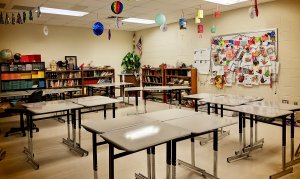In Rural and Urban Communities, Kids Still Struggle to Get Online
Two teachers, one urban, one rural, reflect on what the divide looks like in their communities, and what they’re doing to help bridge the gap.
Your content has been saved!
Go to My Saved Content.As a graduate student a decade ago, I completed a yearlong project on the impacts of the digital divide in schools. Back then, I was struck by the complexities and nuances of the problem, realizing quickly that the divide wasn’t only about connecting to the internet—as it had been when the term was coined in the mid-1990s—but also about how it’s accessed and used.
With remote learning at the top of educators’ minds during the Covid-19 pandemic, the topic of digital equity is center stage again, and I’m sad to see that not enough has changed in 10 years. According to a recent report from Common Sense Media, nearly 12 million students don’t have the technology they need to learn from home during the current crisis, and in some states, like Oklahoma and Mississippi, more than a third of students have no access to the internet at all.
These disparities have exacerbated deeply embedded inequities within our society tied to class, race, and geography. While school systems around the country have quickly pursued commendable fixes like mobile hot spots, device lending, and Wi-Fi buses, problems this big—and this persistent—are tough to tackle in a few months. We got the perspectives of two teachers, one rural, one urban, on what the divide looks like in their communities and what they’re doing to help bridge the gap.
Christy Ford, Teacher: Boyd County, Kentucky
In rural eastern Kentucky, internet access isn’t only a socioeconomic concern; it’s also about geography. There are places here in Boyd County that just don’t have connection—out county roads and up hollows where the internet doesn’t reach and cell coverage is sketchy and unreliable.
While the students who live out there are prepared for the isolation during Covid-19 in a way I don’t fully understand, it’s not the type of isolation that can be resolved with better internet connectivity. For them, school has always been their social network and their internet hookup, and the loss of both has deepened their alienation.

Even for those students who can get online, connecting is never simple. While the school set up Wi-Fi hot spots in rural parking lots around the county, there’s still a logistical challenge to get to them, making it hard for students to meet deadlines. I received a panicked message from one of my students the other day while she sat in a parking lot, overwhelmed by the amount of written material she was looking at for the first time on a Chromebook she had borrowed from the school. Data usage and billing costs also complicate matters for many of these students, who rely upon their smartphones for connectivity.
Building relationships: Still, I’ve continued to post assignments in Google Classroom and make print copies, and I provide one-on-one daily instruction through a variety of platforms—whatever works for them. Yet it’s hard to persuade some students to tackle the barriers to engage online when they have other pressing concerns. Many of my students are essential workers who are on the job during hours that they might have been dedicating to their education. You can’t turn down work in a community that's had 792,000 new unemployment claims since mid-March. Others are already moving into their chosen fields—skilled trades, the military—and just want to receive their diploma. I applaud their adaptability, even as I mourn their rites of passage.

When we do connect, I’ve found that our communication is largely nonacademic, and they are turning to me for stability and emotional support in a way that I have not seen in my more than 20 years of experience. I’ve seen the shift in my own outreach, too. Zoom meetings tend to focus on wellness check-ins; posts on my professional social media tend to be about self-care or resources to turn to when they’re in a bind. It sounds strange to say because I have always enjoyed a close relationship with my students, but distance learning has brought me closer as I fulfill a different need for them than I ever did in the classroom.
As we approach graduation, I worry about sending kids into the world unprepared, as learning has slipped these last few months. But then I remind myself how well most of them have adapted, how they have solved problems and sought out resources, and how they have applied the skills they have learned to meet their new needs. I realize that despite the things that have divided them from traditional education—closure, tech access, geography—they are probably better prepared to cope with their new world than I could have ever hoped.
Marissa King, Teacher: Tulsa, Oklahoma
Built on the boom and bust of oil money, Tulsa, population 400,000, has a tragic history of racism and segregation that has created deep chasms of educational opportunity in our schools: More than 80 percent of students are economically disadvantaged. Over the past five years, I’ve watched the impact of budget cuts in schools where parents can’t afford to fill in the holes and teachers are already stretched thin with large classes.
Unlike many of Oklahoma’s rural areas, Tulsa has widely available home broadband service, but it’s cost-prohibitive for many families even if they see its value. In pre-coronavirus days, many of my students could complete internet-reliant homework by cobbling together strategic stops at public libraries, community centers, and even the local McDonald’s. But due to business closures, these options are now mostly unavailable. While many internet providers have publicized free internet or internet assistance, programs focus on new subscribers, offer 60-day trials, or require past bills to be paid up—a big ask when families are struggling with an uncertain economic future.
Even in households with broadband access, the internet can be unreliable and slow—the more affordable Wi-Fi packages are also the balkiest—making it a challenge to complete assignments on time or engage fully in learning. With everyone at home, this problem is exacerbated, and formerly workable internet connections are now overburdened when every family member needs access simultaneously. One student described how he and his three siblings are taking turns completing online schoolwork because multiple users mean long wait times for pages to load.

Without adequate internet or enough devices to go around, some students have turned to their smartphones; but they have shared, unsurprisingly, that using a phone to write an essay or turn in written work is incredibly difficult.
Homegrown solutions: Over the last two months, educators across Tulsa have scrambled to lend devices and provide mobile hot spots, but while these are laudable efforts, they don’t solve the problem. As a result, teachers like me are watching in frustration as students miss live sessions, don’t log in at all some days, or send apologetic messages that their internet is too slow to load videos.
During one of my recent live teaching sessions, Tallulah, a straight-A middle school student, kept looking for chances to contribute to the virtual conversation, but her home internet couldn’t keep up with fast-moving video: By the time it finished buffering, our class had already moved on to the next problem. She eventually gave up in frustration.
On a smaller scale, schools and teachers are finding their own work-arounds to meet families’ needs, like ditching internet-based assignments or giving parents a say in how their child turns in work. Many support staff positions, like counselors and SEL coordinators, are filling new roles, such as partnering with teachers to check in with individual students by phone. My school also established strict schedule guidelines that stagger each grade level’s live teaching time to allow families to pass one device from sibling to sibling, if needed.
Looking ahead: We still face significant, unresolved issues as we close the school year and prepare for summer learning.
I’m scared that many students facing tech hurdles will fall behind their peers or grow increasingly frustrated. Like many other teachers, I’m worried that unreliable internet access will hamper essential relationship-forming activities and collaboration if we find ourselves starting a new school year online.
In a physical classroom, we would never dream of passing out workbooks to only part of the class, but somehow, many decades into the digital era, we still haven’t figured out how to give everyone the supplies they need to adequately participate in school from a distance. The most fervent commitment to school can’t make up the financial gap needed to pay a family’s monthly internet bills.
